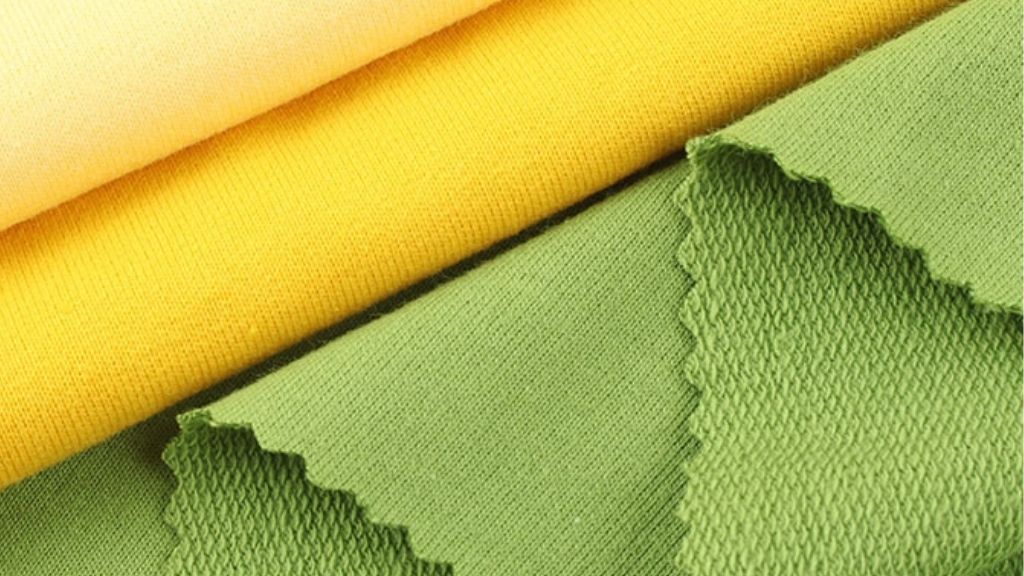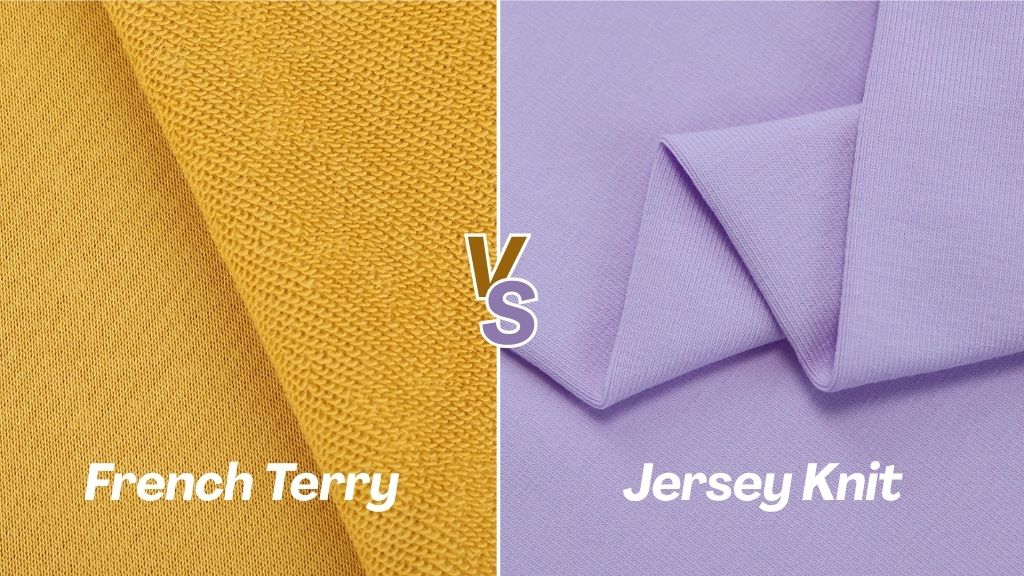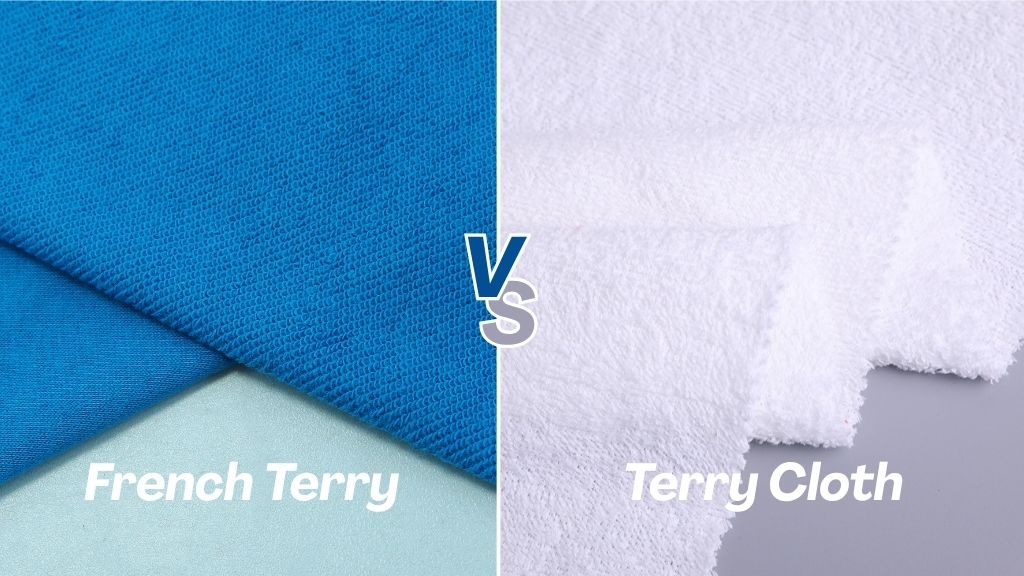What Is French Terry Fabric: The Ultimate Guide

French Terry fabric, known for its soft texture, breathability, and lightweight comfort, is a popular choice for hoodies, sweatshirts, joggers, and loungewear. But what exactly is French Terry? How does it differ from other fabrics? And why is it so beloved? In this ultimate guide, we’ll explore everything you need to know about French terry cloth. Let’s begin!
What Is French Terry Fabric?
French Terry fabric is a type of knit textile known for its distinctive looped texture on the inside and smooth surface on the outside. These small, soft loops are what make the fabric naturally absorbent, breathable, and incredibly comfortable to wear. Unlike regular woven fabrics, French Terry is made using a knitting technique that gives it flexibility and stretch, making it ideal for garments designed for movement and relaxation.
Typically made from cotton or cotton blends (such as cotton-polyester or cotton-spandex), French Terry strikes a perfect balance between softness, durability, and easy care. It’s thicker than a standard jersey knit but lighter than fleece, offering just the right amount of warmth without feeling heavy.
In short, French Terry is the ultimate “in-between” fabric—cozy yet breathable, structured yet flexible. That’s why it has become a favorite choice for everyday essentials like sweatshirts, hoodies, joggers, and casual loungewear.
History and Origin of French Terry Cloth
The origins of French Terry can be traced back to 18th-century France, where the fabric first appeared as a comfortable and absorbent textile for leisure and athletic garments. The term “Terry” is believed to come from the French word tirer, meaning “to pull,” which refers to the process of pulling loops through the fabric during knitting to create its signature soft, looped texture.
Originally, terry fabrics were used for towels and bathrobes due to their absorbency. Over time, manufacturers began refining the knit to create a lighter, smoother version—what we now know as French Terry. This innovation offered the same cozy comfort but with a polished exterior, making it suitable for apparel rather than just bath textiles.
By the mid-20th century, French Terry became a staple in sportswear, especially for athletic sweatshirts and joggers, offering both flexibility and breathability. Today, it has transcended its athletic roots, becoming a key fabric in modern athleisure and casual fashion. Its combination of functionality and style perfectly fits today’s demand for comfort-driven clothing that still looks refined.
What Is French Terry Material Made Of?
French Terry is primarily made from cotton, but it can also be blended with synthetic fibers such as polyester or spandex to enhance its durability and elasticity. The choice of fiber blend determines how the fabric feels, performs, and wears over time. Regardless of the fiber content, French Terry always features its signature looped interior and smooth exterior. This unique structure makes the fabric both breathable and lightly insulating, ensuring comfort throughout the year.
| Material Type | Characteristics | Applications |
| 100% Cotton French Terry | Soft, breathable, and natural. May shrink slightly but provides a comfortable hand feel | Everyday casualwear including hoodies, sweatshirts, and loungewear |
| Cotton-Polyester French Terry | Combines natural cotton comfort with added durability and reduced shrinkage | Sweatshirts, joggers, and activewear |
| Cotton-Spandex French Terry | Offers stretch and excellent shape retention | Yoga apparel, fitted sweatshirts, and flexible joggers |
| Polyester French Terry | Durable, wrinkle-resistant, and quick-drying | Sweatshirts, hoodies, joggers, activewear, and lightweight outerwear |
| Bamboo French Terry | Naturally soft, moisture-wicking, and antibacterial | Premium loungewear, babywear, and lightweight casualwear |
| Organic Cotton French Terry | Produced with minimal chemical input and environmentally friendly | Sustainable fashion, casualwear, and eco-conscious activewear |
What Are the Properties of French Terry Fabric?
Softness and Comfort
French Terry is renowned for its naturally soft hand feel and smooth surface. The fine knit structure and cotton-rich composition create a fabric that is gentle against the skin while maintaining a substantial yet lightweight body. It delivers exceptional comfort for daily wear without feeling heavy or restrictive.
Breathability
One of the most valued characteristics of French Terry is its breathability. The small, uncut loops on the interior promote air circulation and prevent heat from building up, which helps regulate body temperature. This makes it comfortable to wear in both warm and cool conditions.
Moisture Absorption
The looped backing also enhances the fabric’s moisture-absorbing ability. French Terry draws perspiration away from the skin and allows it to evaporate naturally, keeping the wearer dry and comfortable during casual activities or light exercise.
Light Insulation
French Terry offers a gentle level of warmth without excessive weight or bulk. The knit structure traps small pockets of air that provide mild insulation, making it ideal for layering or wearing in transitional weather.
Flexibility
The knitted construction gives French Terry a natural degree of stretch that moves easily with the body. This flexibility contributes to its relaxed fit and makes it particularly well suited for garments designed for comfort and motion, such as joggers and sweatshirts.
Durability
French Terry is durable and maintains its shape well through regular wear and washing. The tight knitting prevents sagging and helps resist pilling, especially in high-quality cotton or blended versions. Its resilience ensures that garments retain a clean, polished look over time.
Ease of Care
In addition to comfort and durability, French Terry is low-maintenance. It can be machine washed, dries relatively quickly, and resists wrinkles, making it a practical choice for modern everyday clothing.
What Are the Common Uses of French Terry Fabric?
Hoodies and Sweatshirts
French Terry is often used to make hoodies and sweatshirts, aiming to balance comfort and sophistication. Its smooth exterior supports detailed printing, embroidery, and structured silhouettes, while the interior loops add a subtle layer of warmth.
Sweatpants and Joggers
Sweatpants and joggers made from French Terry offer exceptional comfort and freedom of movement. This fabric’s resilient knit construction helps prevent bagging and ensures a clean fit, even with frequent wear.
Casual Wear and Outerwear
French Terry cloth is often chosen for casual jackets, pullovers, and light outerwear. Its breathable structure and moderate warmth make it suitable for layering in transitional seasons.
Activewear
The combination of flexibility, breathability, and moisture control makes French Terry well suited for light activewear. It performs effectively in pieces such as warm-up tops, training layers, and yoga apparel, offering comfort and ease of movement during low- to moderate-intensity activities.
Kids and Babywear
French Terry is particularly valued in kids and baby clothing due to its softness and durability. It is commonly found in baby rompers, sweatshirts, joggers, hoodies, playsuits, and other clothing.
Loungewear
Loungewear made from French Terry embodies relaxed elegance. Its mid-weight construction provides a sense of coziness, making it suitable for both indoor comfort and casual social settings.
Home and Lifestyle Products
Beyond apparel, French Terry is also used in a range of lifestyle items such as robes, blankets, throws, cushion covers, and home accessories.
Differences Between French Terry and Other Fabrics
French Terry vs Fleece
Fleece is generally thicker and more insulating than French Terry, making it ideal for garments intended for colder conditions. In contrast, French Terry provides moderate warmth with a lighter weight, allowing for better breathability and a more relaxed drape. Fleece typically features a brushed surface throughout or on the interior, whereas French Terry has loops only on the inside, giving it a smoother exterior suitable for a polished appearance.

French Terry vs Jersey Knit
Jersey knit is lighter, thinner, and more stretchable than French Terry, making it ideal for lightweight T-shirts and layering garments. Unlike French Terry, jersey has no looped backing and offers minimal insulation. French Terry’s looped interior and slightly heavier body provide subtle structure and moderate warmth, lending garments a more composed and versatile look.

French Terry vs Terry Cloth
Although both fabrics feature looped interiors, traditional terry cloth is thicker and primarily designed for absorbency, as in towels and bathrobes. French Terry is lighter, more flexible, and optimized for apparel. Its smooth exterior supports design details and a neater silhouette, whereas terry cloth prioritizes function over refined appearance.

How to Care for French Terry Fabric?
Gentle Washing Practices
French Terry garments should be washed with care to maintain their structure and longevity. Using cold or lukewarm water with a mild detergent helps prevent excessive shrinkage and preserves the integrity of the fibers. Machine washing on a gentle cycle is recommended, and garments should be turned inside out to protect the looped interior and any surface detailing.
Avoiding Heat Damage
High temperatures can affect the shape and texture of French Terry. It is advisable to avoid hot water washes and high-heat drying. Air drying is preferred, but low-heat tumble drying can be used when necessary. This approach minimizes stretching, shrinkage, and potential degradation of the fabric over time.
Minimizing Wear and Pilling
Although durable, French Terry can develop pilling in areas of frequent friction. Washing garments with similar fabrics, avoiding rough surfaces, and using a fabric softener sparingly can help maintain a smooth surface. Regularly inspecting and addressing minor pills with a fabric shaver or gentle combing extends the garment’s lifespan.
Storage Recommendations
To retain shape and appearance, French Terry garments should be folded rather than hung for extended periods, as hanging can stretch shoulder seams and necklines. Storing in a cool, dry environment also helps prevent fiber degradation and maintains color vibrancy.
FAQ
Q1: Is French Terry fabric better for summer or winter?
French Terry is a versatile fabric that can be worn in both summer and winter seasons. However, this depends on the thickness of the fabric. In cooler months, it provides moderate warmth and works well for layering, though it is not as insulating as fleece.
Q2: Does French Terry shrink after washing?
French Terry may shrink if washed in hot water or dried on high heat. To prevent shrinkage, wash in cold water, use a gentle cycle, and either air dry or tumble dry on low heat.
Q3: Is French Terry suitable for athletic wear?
Yes! French Terry is breathable, flexible, and moisture-absorbent, making it ideal for light workouts, yoga, jogging, and other casual athletic activities.
Q4: How long does French Terry clothing last?
With proper care, French Terry clothing can last for years. Avoid high-heat washing and drying, and minimize friction to maintain the fabric’s softness and shape.
Q5: What’s the difference between French Terry and Terry Cloth?
French Terry has a smooth outer side and a looped inner side, often used for casual clothing. Terry Cloth is thicker, fully looped, highly absorbent, and commonly used for towels and bathrobes.
Working With Facto Textile
We promise you:
- A wide variety of high- quality fabrics
- Full range of customized services
- Professional production technology
- Sincere Cooperation
Contact Us To Start Your Fabric Project
Please send us your message, we will reply within 20 hours.
